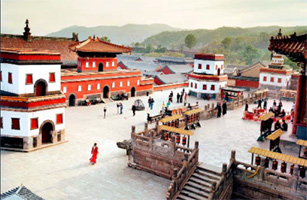
Before Disney, China’s first amusement park was Chengde in Hebei province. Call it Qingland — in honor of the decadent Qing dynasty that walled off 5.6 sq km of rolling forest to create a summer retreat 230 km northeast of Beijing.
But forget Space Mountain or It’s a Small World. The attractions on these carved-out hunting grounds, aside from the few deer left as a reminder of former wildlife , are some 120 preserved palaces, pavilions and pagodas constructed over 89 years beginning in 1703. Many were built as places from which to enjoy 72 artfully landscaped scenic points, and they bear names like the Hall of Refreshing Mists and Waves, and Viewing Misty Mountain Tower. Some are situated in areas where the rising moon and setting sun are reflected simultaneously.
The architecture and adornments of this 18th century showcase reflect another preoccupation of the Manchu Emperors: the need to instill unity among China’s various ethnic groups. The harmony they expected of their subjects is expressed in eight opulent Buddhist temples that fused Han, Tibetan and Mongolian building styles. Each is the sort of attraction that can be satisfying for an afternoon, yet once fully entered is inexhaustible in its cultural reference points.
Because it’s a bit too far from Beijing for a day trip and is often confused with Sichuan’s far larger Chengdu, Chengde is blissfully off most foreign tourists’ itineraries, and the big-brand hotels have yet to hang out their shingles. This mountain city thus remains one of China’s special spots, proving through changing seasons that when it comes to choice locations, a bunch of thrill-seeking tyrants on horseback can’t be wrong. Here are five reasons to visit.
1. IMPERIAL PLEASURESWhile Beijing’s Forbidden City often feels like a cold, exhausting exercise in obligatory touring, Chengde’s smaller and more intimate royal digs are full of accessible joys. The Mountain Resort for Avoiding the Heat, to use the complex’s formal name, is made mostly of aromatic nanmu wood, surrounded by stunning blooms and tall cypresses, and cloaked in a piped-in soundtrack of beautifully plucked guzheng. It also offers a sense of how Manchu VIPs actually lived, with glassed-in glimpses of bedchambers, lounging areas and altars — along with the notorious Empress Dowager Cixi’s cigarettes, hand warmers and ivory combs, and a silk coat for one of her dogs. Even the usual exhibits of cloisonn, porcelain and Chinese-zodiac sculptures are executed with style and can be easily managed before the onset of antiquity fatigue.
2. TIBET WITHOUT ALTITUDE SICKNESSDon’t have the time, budget or conditioning to tackle Lhasa? Chengde provides the second best thing with its Tibetan-influenced temples, including Putuo Zongcheng Temple — a mini Potala Palace — and Xumi Fushou Temple. Puning Temple is the most renowned, mainly for a bodhisattva with a thousand hands and eyes , but it’s also marred by trinket shops and a stark new parking lot. Pule — with its circular shrine resembling the Temple of Heaven — is the most peaceful and remote, but all eight architectural pastiches are within relatively short distance of each other, even if without reliable transport links for independent travelers.
3. MOUNTAIN HIGHS While Chengde’s sterile downtown is growing inexorably, now ringed with the usual brace of housing towers, the city’s main draw remains its temperate climate and crisp mountain air. By Chinese standards, the old imperial grounds and environs are one huge escape from the rest of the country’s dust, trash, neon signage and pollution. If tourism officials there were smart, they’d quit emphasizing forgotten royals in favor of a more contemporary desire for health and rejuvenation. While the hour-plus, open-air bus rides around the higher, less frequented areas of the Mountain Resort are only available seasonally , all of Chengde is a blast of fresh air and uncluttered vistas.
4. THE CALL OF THE WILD MEATS Fresh-killed game may have been a major imperial preoccupation, but China’s taste for the medicinal powers of rare forms of flesh are especially evident in Chengde’s many restaurants. It’s not just wild boar or venison that’s stir-fried there but also deer fetus, turtle and donkey meat, served with a host of local mushrooms and special herbs. On the way to the Mountain Resort, a row of showy establishments puts on nightly Man-Han banquets — named for their unifying assortment of Han Chinese and Manchu treats — but travelers may find the slick Xin Qianlong restaurant on Xinhua Lu, tel: 207 2222, a more modern way of experiencing some of the city’s most digestible forms of imperial culinary legacy.
5. PARTICIPATORY AUTOCRACY In addition to hiking, boating and bus riding, Chengde offers many ways to experience the olden days firsthand. The usual photo ops for dressing in imperial-style drag are offered at every turn, but there’s also the chance to be hauled up steep temple climbs in a covered palanquin or take a cable car to one range topped with the single, auspiciously phallic Hammer Rock. Best of all, visitors can spend the night in one of 28 Mongolian yurts — now augmented with air-conditioning and cable TV — that were originally reserved for tribal delegations and remain the only accommodation within the Mountain Resort.
Got an awful travel gripe? The Avenger may be able to sort it out for you. Click here to tell us your problem.
See Time.com/Travel for city guides, stories and advice.